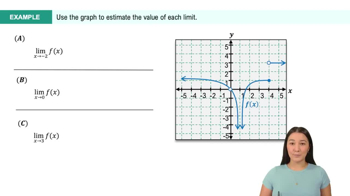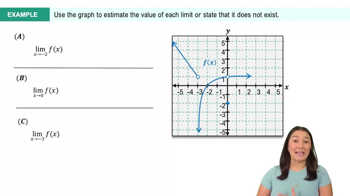Table of contents
- 0. Functions7h 52m
- Introduction to Functions16m
- Piecewise Functions10m
- Properties of Functions9m
- Common Functions1h 8m
- Transformations5m
- Combining Functions27m
- Exponent rules32m
- Exponential Functions28m
- Logarithmic Functions24m
- Properties of Logarithms34m
- Exponential & Logarithmic Equations35m
- Introduction to Trigonometric Functions38m
- Graphs of Trigonometric Functions44m
- Trigonometric Identities47m
- Inverse Trigonometric Functions48m
- 1. Limits and Continuity2h 2m
- 2. Intro to Derivatives1h 33m
- 3. Techniques of Differentiation3h 18m
- 4. Applications of Derivatives2h 38m
- 5. Graphical Applications of Derivatives6h 2m
- 6. Derivatives of Inverse, Exponential, & Logarithmic Functions2h 37m
- 7. Antiderivatives & Indefinite Integrals1h 26m
1. Limits and Continuity
Introduction to Limits
Problem 2.7.49
Textbook Question
Determine whether the following statements are true and give an explanation or counterexample. Assume a and L are finite numbers and assume lim x→a f(x) =L
d. If |x−a|<δ, then a−δ<x<a+δ.
 Verified step by step guidance
Verified step by step guidance1
Step 1: Understand the statement: The statement is about the definition of the limit of a function as x approaches a. It involves the concept of a delta (δ) neighborhood around the point a.
Step 2: Recall the definition of a limit: The limit of f(x) as x approaches a is L, written as \( \lim_{{x \to a}} f(x) = L \), if for every \( \epsilon > 0 \), there exists a \( \delta > 0 \) such that if \( 0 < |x - a| < \delta \), then \( |f(x) - L| < \epsilon \).
Step 3: Analyze the given condition: The condition \( |x - a| < \delta \) implies that x is within a distance δ from a. This means x is in the interval (a - δ, a + δ).
Step 4: Verify the statement: The statement 'If \( |x - a| < \delta \), then \( a - \delta < x < a + \delta \)' is indeed true by the definition of absolute value and the concept of a δ-neighborhood.
Step 5: Conclusion: The statement is true because it directly follows from the definition of the absolute value and the concept of a δ-neighborhood around a point a.
Recommended similar problem, with video answer:
 Verified Solution
Verified SolutionThis video solution was recommended by our tutors as helpful for the problem above
Video duration:
2mPlay a video:
Was this helpful?

 6:47m
6:47mWatch next
Master Finding Limits Numerically and Graphically with a bite sized video explanation from Callie
Start learning





